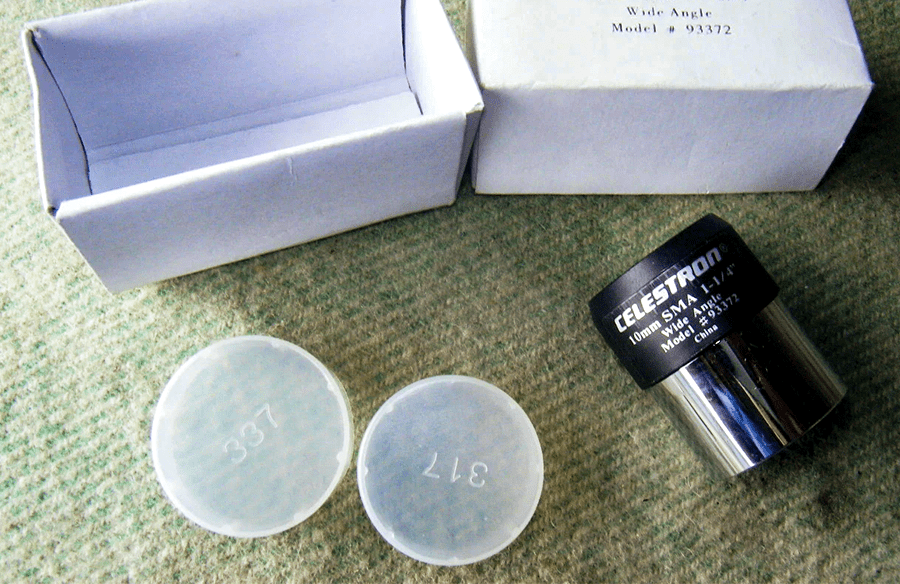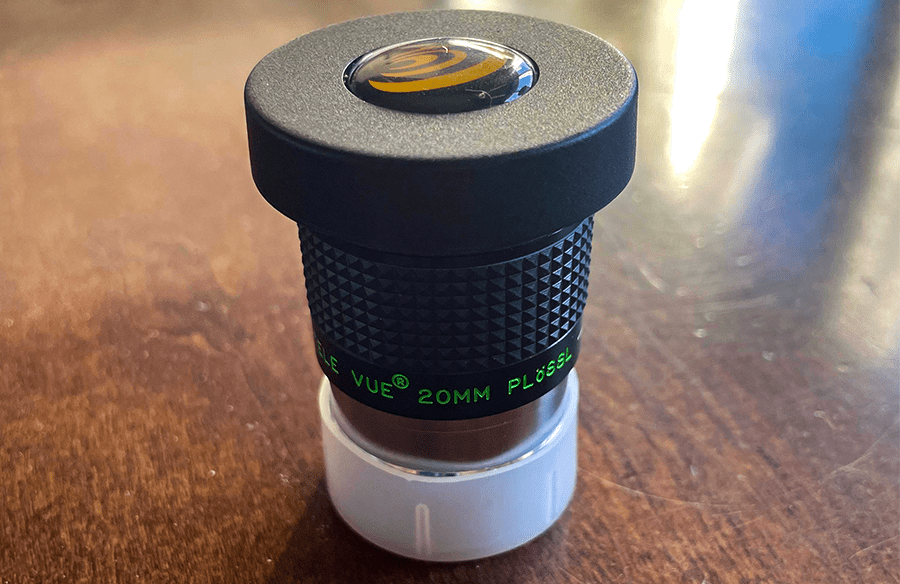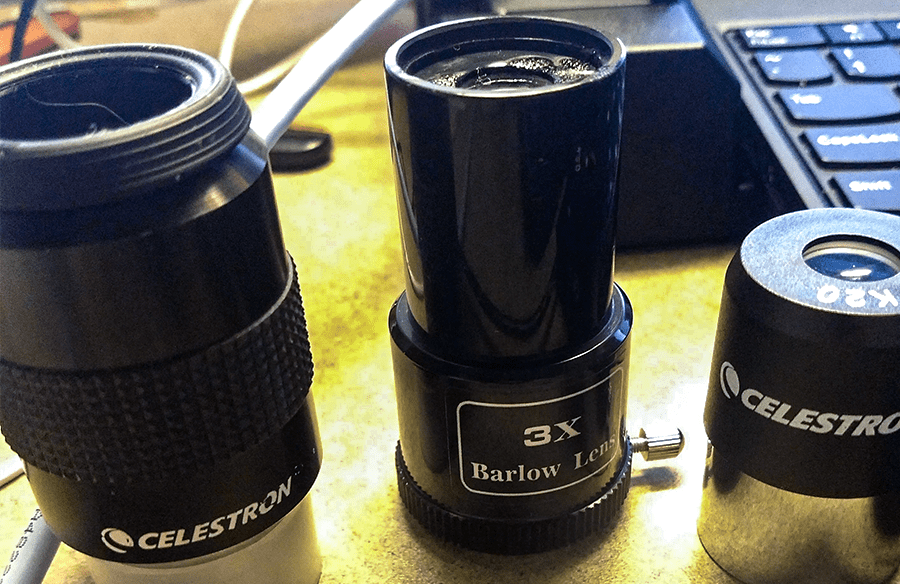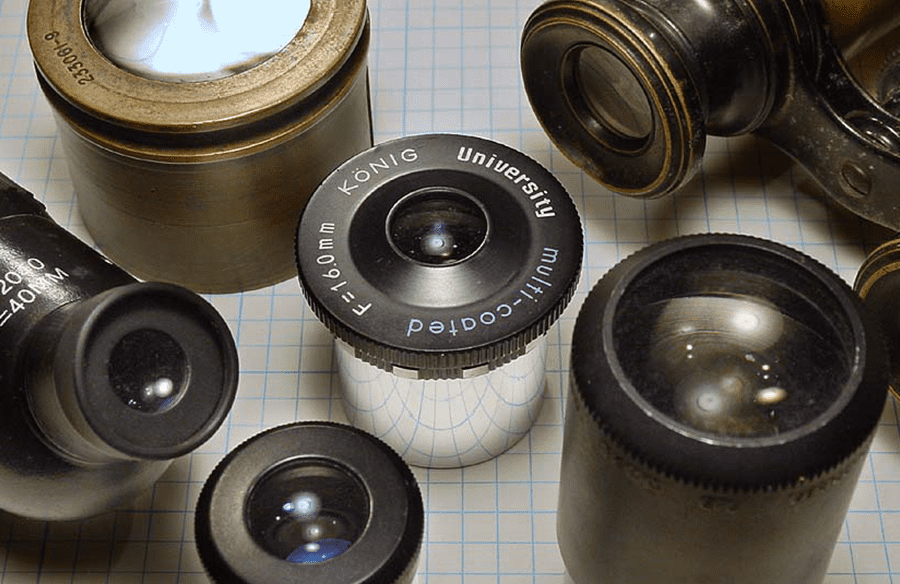So you’ve bought yourself a shiny new telescope, or you’ve dug an old one out of the attic, or perhaps you have your telescope all set up and working nicely but you get upgrade-itis and have a nagging feeling that there is more quality that can be wrung from your telescope?
Whilst idly reading the instruction manual one day (which you always read in full of course) you see that it comes with a Kellner eyepiece and a Plossl eyepiece. Maybe a 40mm kellner and a 25mm Plossl, as a likely possibility.
What, you ask yourself, do these names, ‘Kellner’ and ‘Plossl’ mean? A quick look at shops selling eyepieces will further convince you that these words need to be understood to ensure you make an informed purchasing decision if you want to buy another eyepiece.
Well in a nutshell, the difference between a Kellner and a Plossl is that a Kellner has 3 lenses in the eyepiece, while a Plossl has 4, which can have an effect on the optical consequences that arise from how these lenses are shaped and positioned.
Contents
Kellner eyepiece design

The Kellner eyepiece design dates back to the 1850’s when a chap called Karl Kellner set out to deal with some of the issues with eyepiece design at the time; namely distortions to the image caused by spherical and chromatic aberrations.
In plain English this means that the eyepieces of the time may have looked like a badly tuned old analogue TV (though Mr Kellner would not have been able to make this comparison), with colors ‘fringing’ around bright objects like the moon and the shape of objects not being totally correct; stars not showing up as circular points of light for example.
Color fringing is caused by the constituent colors of light coming to focus at slightly different points when they pass through a lens, think of this like a rainbow. So the solution that Mr Kellner came up with was to design an achromatic – refracts light without dispersing it into its constituent colors – eyepiece.
The design of the eyepiece is a three lens design which consists of a doublet-2 lenses cemented together and another single lens, all cleverly shaped and arranged so that they help correct many of the issues that previous simpler designs created.
Today the Kellner eyepiece design is considered to be the minimum standard that should be used for serious observing, though that does not necessarily mean it has to be discounted from use in more expensive setups, it just means that older and less refined designs such as Huygens and Ramsden are best avoided and indeed are not even that easy to come by anyway.
Despite all seeming peachy with the Kellner design, its corrections were only improvements, and problems still remain; further corrections required at least one more lens to help solve issues caused by internal reflections which can still leave visible color fringing and distortions.
Plossl eyepiece design

To try to solve the remaining problems with the Kelner design, Gerg Simon Plossl, in the 1860’s added another lens to the eyepiece assembly, basically replacing the lonely single lens of the Kellner with another doublet to join the first doublet of the Kelner.
So the plossl has 4 lenses in series and this, if implemented well, results in brighter more contrasty images which are mostly free of pesky color fringing or shape distortions. I know, it seems counterintuitive that adding more glass in the way of the light improves the image, but you’ll just have to trust me that if the glass is coated appropriately (like the coatings on spectacle lenses) and shaped and positioned correctly, it does !
Of course this is now a more complex design, so there is more to potentially go wrong, which means that there are good, bad, ugly and beautiful plossls out there; buyer beware and read reviews !
Kellner vs Plossl – Which is Better
I’ll start this paragraph with a bold statement; Which is better’ is perhaps not the right question, rather which is better for your needs, your wallet and your equipment (but that doesn’t make a catchy heading).
If planetary observing is your primary goal and you are using a relatively inexpensive telescope, say less than ~£400, at low-medium magnifications, then you can probably relax that ‘upgrade-itis’ urge and happily stick with the Kellner(s) that came in the box with your ‘scope, or even buy some more!

The issues described above may not be very noticeable at all. On the other hand if it’s faint fuzzies (galaxies, nebula) you seek and you are looking to eek out more potential from your telescope, or plan on buying something bigger and better in the future then it is perhaps wise to seek out a quality plossl eyepiece .
The Kellner eyepiece design is simpler and most Kellner eyepieces on the market are fairly consistent in quality because there are fewer things to mess up in their design.
On the other hand the plossl eyepiece design has the potential to produce really excellent results that can be used in all types and prices of telescope, but are more complex to build, so there are bad examples on the market- not all plossls are created equal.
If you are still unsure, go used- after all there is a saying (borrowed from the photographic community); “equipment is rarely really owned, it is merely rented for a while”.
Kellner vs Plossl – Comparison table
In essence the design differences between Kellner and Plossl comes down to the number of lenses within the eyepiece barrel. Well-made lenses are expensive though, so in general the more lenses, the higher the price of the eyepiece.
There is a little bit more to it than that and there are other design differences too, so for those of you who love a table or simply want to skip to the chase, the table below summarizes these differences.
| Features | Kellner eyepiece | Plossl eyepiece |
| Number of elements | 3 | 4 |
| Typical field of view | Narrower; up to 50 degrees | Wider; typically up to 56 degrees |
| Usage | – Relatively cheap. You can build up a collection of different Kellners for less money. – At longer focal lengths and when viewing the planets, the differences in quality versus Plossl for your money can be negligible. – Simple design means less to go wrong in terms of quality so they are more consistent across brands. You are, therefore unlikely to buy a really | – ‘Slow’ telescopes, with longer focal lengths- f6 and above- are good for viewing the gas giant planets and the moon at low-medium magnifications. – Less expensive telescopes mainly, though a good Kellner won’t necessarily be embarrassed in a more pricey setup. |
| Eye relief (of most interest to spectacle wearers!) | – Very short at higher powers; you’ll be glued to the eyepiece! | – Can be much longer; the cone of light from the eyepiece is such that you can be more relaxed about where you position your eye. |
| Pros | – Relatively cheap. You can build up a collection of different Kellners for less money. – At longer focal lengths and when viewing the planets, the differences in quality versus Plossl for your money can be negligible. – Simple design means less to go wrong in terms of quality so they are more consistent across brands. You are, therefore, unlikely to buy a really | – Better corrected and accurate images; wider range of objects can be viewed without distracting distortions. – Some truly excellent Plossl’s are available and these may be the only eyepieces you will have to buy, even if you change the telescope; an eyepiece for life! – Easier and more relaxing to use. The position of your eye at the eyepiece is less critical. – Often sharper image quality. – Wider fields of view (so easier to find objects and keep them centered). |
| Cons | – Not very well ‘corrected’, so image artifacts such as color fringing or slight distortions may be visible. – When you upgrade your telescope you may find image quality issues become more distracting and you may have to spend money again buying a plossl – Narrow ‘cone of light’ means there is a restricted ‘sweet spot’ for viewing distance, so it is a bit less relaxing to use than a plossl. – Can offer a softer, less detailed image. – Narrower field of view (so harder to find | – More complex design means wider range of quality and the risk of buying a ‘lemon’ – More expensive; you may find that you end up only buying one or two plossls. |
Is Kellner vs Plossl the only eyepiece game in town?

Are Kellner and Plossl the only two eyepiece designs? No! That would be far too simple, and when you think about it, in a pursuit that has been around for as long as astronomy, it is unlikely as well. Other eyepiece designs you may have heard of include the likes of Huyghens, Modified Achromat, Monocentric, Orthoscopic, and Tele Vue/Nagler, but there are also many other lesser-known designs that bring their own pros and cons to the table.
As is so often the case however, more expensive designs tend to have fewer compromises or ‘cons’. That said, you may well need a higher quality telescope to realize the benefits of more esoteric designs; there is little point putting a Rolls Royce engine into a moped! The discussion of these designs goes beyond the scope (if you pardon the pun) of this article but will be covered in future features.
Conclusion
In conclusion then, whilst a quick tot of the pros and cons table above will probably lead you to conclude that Plossl eyepieces are better than Kellner’s, the truth is somewhat more nuanced, and for your budget and typical usage scenarios, Kellner may well win the day. Indeed a quick browse of the astronomy forums will reveal that some folk are big Kellner fans.
For many, though, the greater versatility, sharpness, and accuracy of the Plossl design will make the slightly greater financial outlay a price worth paying. The choice is yours and ultimately what your own eyes see matters most.
I would recommend starting out with a Kellner and perhaps buying a second-hand plossl of the same focal length to make a comparison for yourself. If you see the benefits of the plossl described above as a ‘must have’ in your setup then you can be more comfortable with your future eyepiece buying choices.
On the other hand you may see little image quality difference that concerns you and you can be satisfied that you’ve saved a wad of cash and have a bigger collection of Kellner eyepieces to boot!
Happy viewing!

